Grounded Theory: Base Findings on Research, Not Preconceptions

- 416 shares
- 8 mths ago
Grounded theory is a qualitative research method that helps to discover patterns and insights from real user data. Instead of starting with assumptions, researchers collect and analyze data step by step, letting findings emerge naturally to build a deep, unbiased understanding of users' behaviors and needs.
In this video, William Hudson, User Experience Strategist and Founder of Syntagm Ltd, explains grounded theory.
In grounded theory, researchers alternate data collection with analysis until they build a complete picture of user needs and behaviors. Researchers greatly benefit from grounded theory in novel problem domains or when they require a more in-depth understanding of user behavior.
The aim of grounded theory is to allow user insights to guide the research. This way, design teams can discover and solve the most important issues users face, regardless of their initial research or design goals. This contrasts with more traditional forms of research that set out to address a specific concept.
For example, a typical design goal might be:
Improve the user experience of an online supermarket to increase customer engagement.
This approach may exclude insights unrelated to the website's usability and features. For example, participants may have issues with delivery times and product substitutions that influence their decisions more than user experience (UX). However, grounded theory does not focus on finding answers to specific questions, allowing researchers to discover these important insights.
These issues fall outside the immediate scope of the website. However, if the organization ignores them, UX alone is unlikely to achieve the goal of increased engagement. The organization would benefit if the researchers included these findings in their research summary. They can then consider how best to improve customer experience as a whole, not just the website's UX.
Grounded theory is a powerful tool in user experience research, and it has several benefits to offer.
When researchers observe users in situ and interact with them directly, they are better able to explore users’ behaviors and needs in context.
Even when research is limited to interviews without observation, discussions are focused on scenarios in the problem domain rather than abstract lines of questioning. For example, a typical research question might be:
“How satisfied are you with the online checkout process?”
However, a researcher using grounded theory might ask:
“Can you walk me through your last experience checking out your groceries online, step by step? I'd like to understand what you did, how it felt, and if anything stood out to you.”
The focus of grounded theory research is on users in the problem domain. Researchers usually do not address potential solutions in the domain unless they are part of the existing user experience. Therefore, most observations are about stories of use. With diverse participants, this ensures researchers get a better understanding of the user experience.
For example, in other types of research, a question for participants that addresses the problem domain might be:
“Would it be helpful if the supermarket app recommended substitute items when something is out of stock?”
A grounded theory question could be:
“Tell me about the last time you found out something you ordered online was out of stock. How did you handle it, and what did you do next?”
In this video, Don Norman, Father of User Experience design, author of the legendary book The Design of Everyday Things, and Co-Founder of the Nielsen Norman Group, explains the importance of user and human-centered design.
Airplane Cockpit by Riik@mctr (CC BY-SA 2.0)
https://www.flickr.com/photos/riikkeary/24184808394/
Cognitive Science building at UC San Diego. by AndyrooP (CC-BY-SA-4.0)
https://commons.wikimedia.org/wiki/File:Cognitive_Science.jpg
Pseudo-commands to illustrate how line-by-line text editing works. by Charlie42 (CC BY-SA 3.0)
https://en.wikipedia.org/wiki/Ed_(text_editor)#/media/File:Ed_lines.jpgSince grounded theory views usage as a tool of exploration, it’s not uncommon for results to cover a wide range of topics. Naturally, researchers will have established what area they’re interested in and may wish to deliberately exclude issues that are out of scope. However, this is something they should do carefully—if they ignore behaviors or concerns that arise in research; it may be counterproductive.
For example, grounded theory research might reveal that customers are frustrated with limited delivery times. Researchers can share this insight with the operations team, who may then adjust the delivery schedule. However, if they ignore such findings, this could result in a solution that technically meets users' stated needs yet fails to meaningfully improve their overall experience.
When researchers observe or ask participants to walk through scenarios in their lives, they rapidly gain detailed knowledge of user goals, behaviors, and needs. How user goals are defined and prioritized may change throughout research and development until the final solution is complete. However, behaviors are often well-established early on, and grounded theory research is highly effective at discovering them compared to other methods.
Since grounded theory starts without assumptions or theories, it reduces bias by letting user data guide the research. Instead of testing a fixed idea, researchers ask open-ended questions, observe real behavior, and adjust their focus based on what they discover. This approach avoids common biases like:
Confirmation bias: This happens when researchers focus only on data that supports their beliefs and ignore anything that doesn’t. Grounded theory helps avoid this by not starting with a fixed idea. Insights come directly from the data, not from what the researcher expects to find.
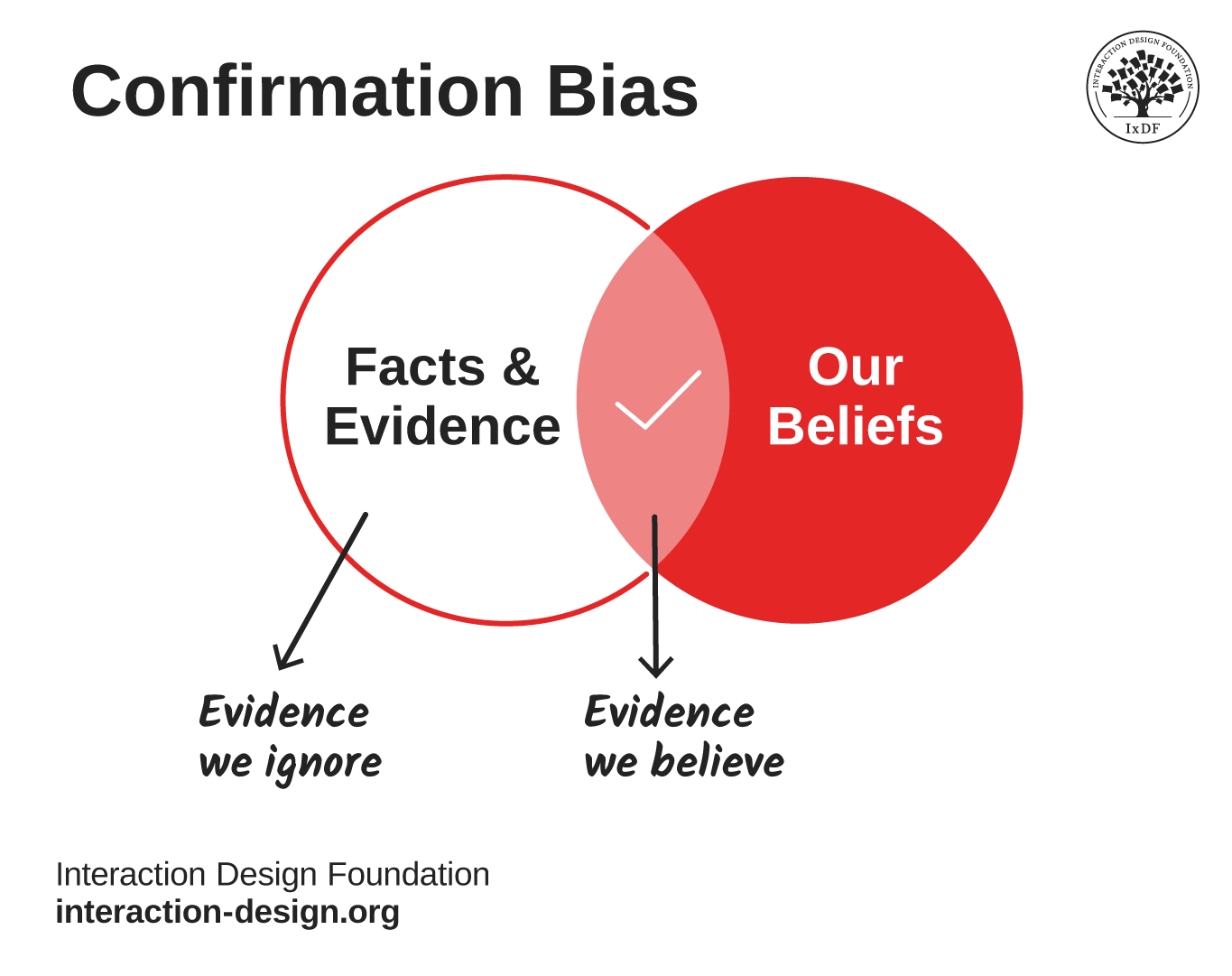
Research built with confirmation bias will directly affect the final product, service, or experience. This is why it is pivotal that researchers stay open-minded and explore avenues that contradict their beliefs.
© Interaction Design Foundation, CC BY-SA 4.0
Framing bias: This occurs when the way a question is worded leads people toward a certain answer. Grounded theory uses open-ended, neutral questions that allow users to speak freely, reducing the risk of steering their responses.
Cultural and personal biases: These appear when a researcher’s background or beliefs affect how they understand user behavior. Grounded theory emphasizes direct user quotes and observations, keeping the focus on what users actually say and do—not how the researcher interprets it.
Follow these steps to use grounded theory in user research.
To apply grounded theory in user research, start with a broad, open-ended research question that explores user needs, behaviors, and challenges within the problem domain.
Grounded theory research questions should be:
Exploratory and designed to uncover new knowledge, not test hypotheses.
Flexible, so you can follow up on emerging areas of interest.
Specific enough to be practical but broad enough to capture complexity.
For example:
“What obstacles prevent in-store supermarket customers from making online delivery orders?”
This question explores a wide range of factors—such as ease of use of online platforms, concerns about product freshness, delivery fees, and preference for in-store shopping—without narrowing it down to a single hypothesis.
Begin your data collection using qualitative methods like observations and interviews.
User observation is often preferable to interviews because it reveals what users actually do rather than what they say they do. People often overlook or misreport their own behaviors. However, direct observation reveals real actions, habits, and workarounds. Observations often expose needs or pain points that users themselves aren’t consciously aware of. When you watch users in their natural environment, you gain deeper, more accurate insights into how products, services, and experiences fit into their lives.
Coding is the process of organizing and making sense of your qualitative data. For example, your interview transcripts or observation notes. Here, you label selections of information with descriptive tags called codes. These codes capture key ideas, actions, or patterns in the data. There are three stages of coding:
Open coding: Begin by analyzing the data line by line and assigning initial codes without any predefined categories.
Axial coding: As patterns emerge, link related codes together around central themes. Develop connections between categories and subcategories to form a coherent framework.
Selective coding: Finally, integrate and refine your categories around a core category so you can develop a cohesive theory.
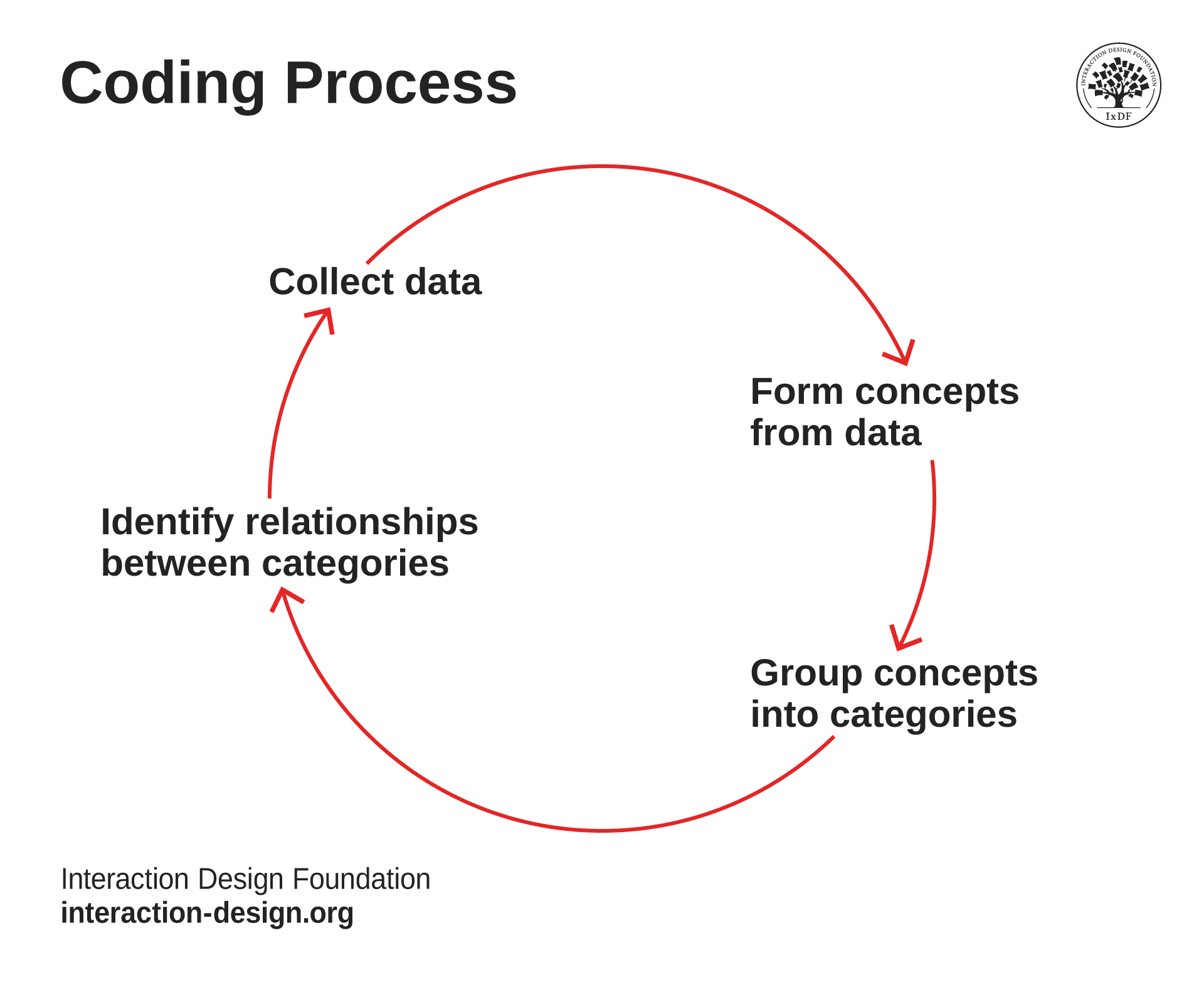
Coding is an iterative process that transforms raw data into a structured theory grounded in real user experiences.
© Interaction Design Foundation, CC BY-SA 4.0
A simple method for coding grounded theory research is with affinity diagrams. Affinity diagrams organize, link, and structure research data into a format upon which design teams can take action.
For a quick start guide to affinity diagramming, download the free template below and start coding your data easily.
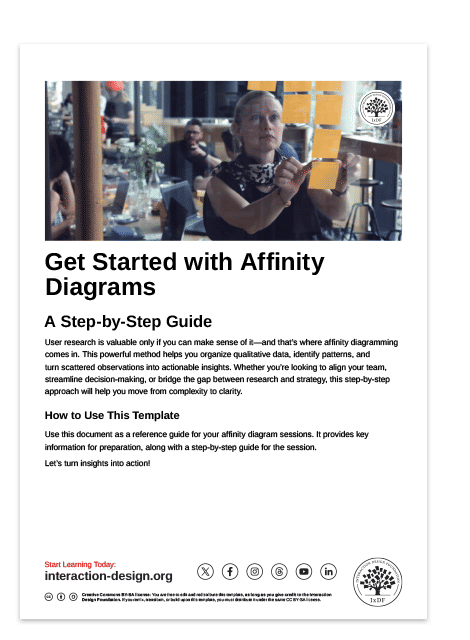

After each open and axial coding session, identify gaps in your data or new, relevant research directions. Conduct further observations or interviews with either the same or new participants if you think it will be more beneficial. Continue this research and analysis process until no new categories emerge in your axial coding.
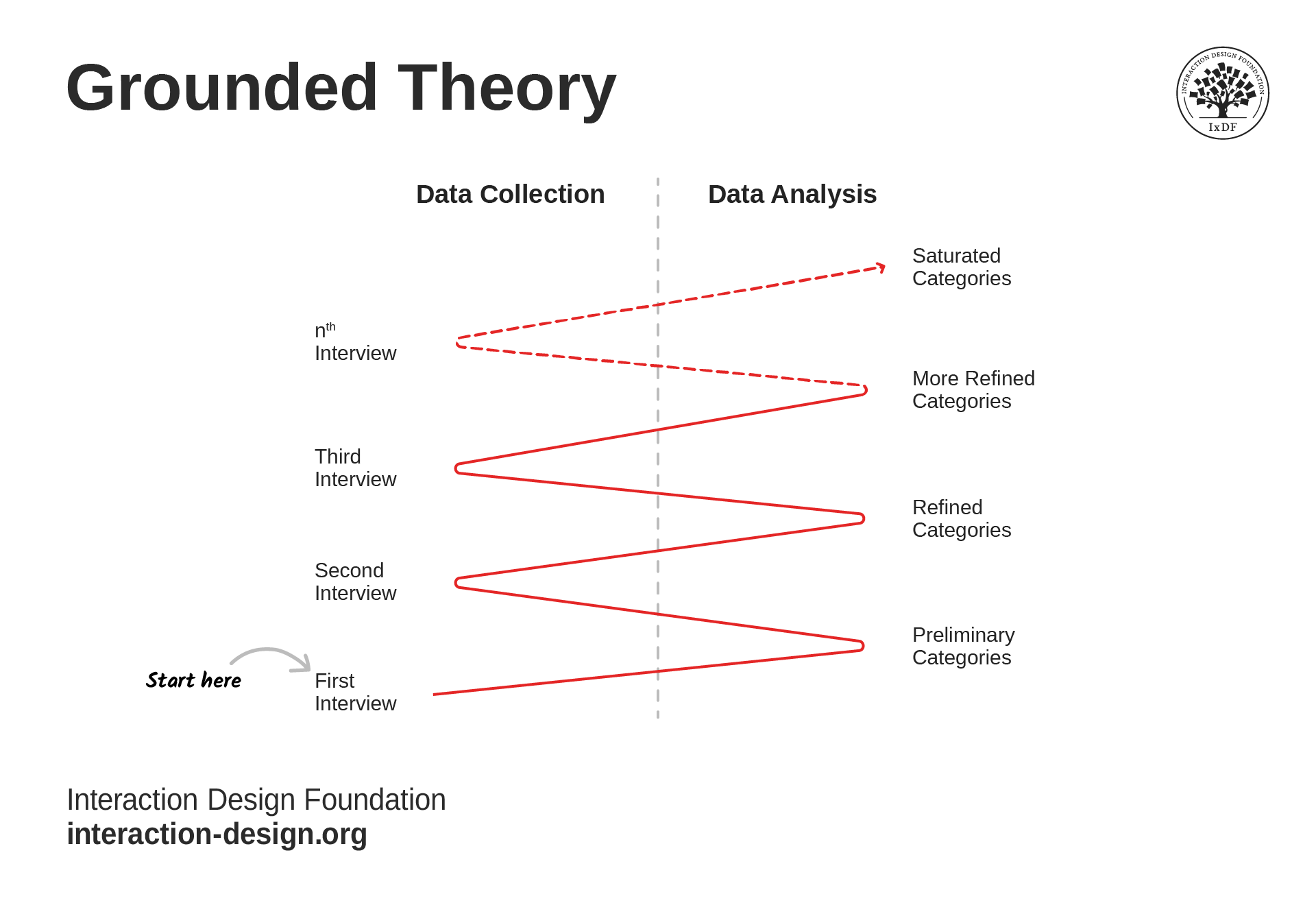
Grounded theory is an iterative process in which data collection and analysis continually inform each other, allowing new insights to guide the direction of the research. It is a cyclical method that identifies emerging patterns, deepens understanding, and adjusts research priorities accordingly. As a result, grounded theory helps produce user-focused solutions informed by genuine user behaviors, motivations, and challenges.
© Image redrawn by Interaction Design Foundation, based on original by John Creswell (Educational Research), Fair use
When no new categories emerge in axial coding, you have reached “saturation.” This is when it is unlikely that further research will reveal new insights.
At this stage, if you are working within a team or organization, you may wish to explore your data with your colleagues and stakeholders. Data exploration helps everyone build empathy and prepare them to build products, services, and experiences that users love.
In this video, William Hudson explains how to capture your research data in preparation for exploration with affinity diagrams.
In grounded theory, you don’t start with a theory—you build one from the ground up using your research data. Theories begin to emerge naturally as you collect data and code it. These patterns become the building blocks of your theory.
Once you reach saturation, look at the concepts and relationships in your coding and ask:
“How do these explain the problem I’ve been researching?”
From here, connect the dots and create a theory. The theory will be a structured explanation of how users experience a particular issue, why it happens, and what influences it.
For example, a design team researches why people abandon online grocery orders. Through interviews and observations, they notice common themes:
Confusion about delivery slots.
Lack of trust in product quality.
Frustration with item substitutions.
As they code, conduct further research, and finally complete selective coding, they realize many users start excitedly but gradually lose confidence and control. This leads to their theory:
“A sense of lost control and uncertainty leads users to abandon online grocery orders.”
Download this template to start implementing grounded theory in your research straight away. It includes a quick guide on grounded theory, plus a worksheet to plan and record your research.
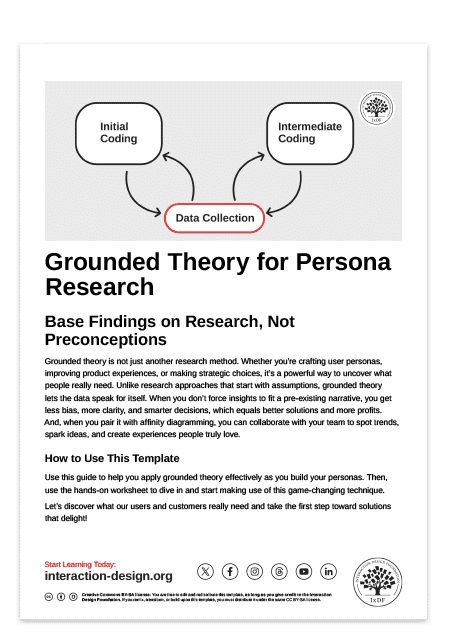

Grounded Theory was developed in the mid-1960s by sociologists Barney G. Glaser and Anselm L. Strauss:
1967: The Discovery of Grounded Theory: Strategies for Qualitative Research by Glaser and Strauss. This book describes the motivation for grounded theory and focuses on how important it is to derive theories from research data.
1970s-1980s: Grounded theory finds increasing use in social research and related fields. What’s more, the theory was adapted to meet a wide range of needs.
Divergence: In the late ’70s and early ’80s, Glaser and Strauss's views on grounded theory began to diverge—namely in how:
Barney Glaser preferred a more flexible approach and was enthusiastic about minimal researcher interference when developing theories from collected data.
Anselm Strauss and Juliet Corbin developed a more systematic version of grounded theory, and their approach was far more detailed and prescriptive.
1990: Strauss and Corbin published Basics of Qualitative Research: Grounded Theory Procedures and Techniques. This became a step-by-step guide to grounded theory research, including coding techniques and the development of theoretical frameworks.
1990s-2000s: Multiple practitioners adapted and extended grounded theory, resulting in several new versions.
2010s-Present: Grounded theory is still used widely in qualitative research across a range of fields, including psychology, education and medicine.
Technological advancements: The more extensive use of computing has helped researchers manage data collection and analysis processes, and more sophisticated forms of data analysis have become available.
Learn how to apply grounded theory in user research and build personas that drive user-centered design in our course, Personas and User Research: Design Products and Services People Need and Want.
Read Barney Glaser and Anselm Strauss’s book that laid the foundation for grounded theory, Discovery of Grounded Theory.
Explore Anselm Strauss and Juliet Corbin’s book, Basics of Qualitative Research: Grounded Theory Procedures and Techniques, for a step-by-step guide to their more detailed approach.
Discover more about grounded theory in Pramod Khambete and Uday Athavankar’s article, Grounded Theory: An Effective Method for User Experience Design Research (PDF).
Memo writing helps researchers build theory in grounded theory research by recording ideas during data analysis.
As researchers look at interview or observation data, memos help them remember and develop thoughts about patterns, codes, and meanings. This process turns data into theory.
Writing memos is important because it:
Captures thinking: Memos keep track of ideas and insights as they happen.
Supports theory building: Researchers use memos to connect categories and find deeper meaning.
Improves reflection: Memos help researchers understand and compare data better.
To get the most out of your memos, you should:
Write memos often: Don’t wait—write short notes during coding.
Use simple language: Focus on what you see, think, or wonder.
Review and update: Add to memos when you learn something new.
For example, if users often say they feel “lost” in an app, a memo could suggest a theme like “navigation problems.” Later, this could help form a theory about user experience.
In this video, William Hudson, User Experience Strategist and Founder of Syntagm Ltd, presents a human-centered approach for recording observation and interview notes.
Theoretical sampling is a way researchers collect data step by step during a study. They don’t plan everything at the start. Instead, they look at early results and then choose new people or situations to study based on what they find. This helps them build a strong theory.
Researchers begin with a few interviews or observations. If they see a pattern—for example, how users act when using an application—they then study other users in different situations. This helps them better understand the pattern or find exceptions.
This method helps researchers go deep and focus only on what matters. They start broad, then narrow their focus based on what they discover. This keeps their research clear and useful. They stop collecting data when no new ideas appear—this is called theoretical saturation.
Grounded theory originated in sociology but has since become a widely adopted qualitative research method in fields like psychology, education, healthcare, information systems, and design. Its strength lies in its systematic approach to generating theory from data, particularly in areas where existing theories fall short or lack specificity.
Grounded theory focuses on understanding social processes, behaviors, and experiences directly from real-world data. This makes it particularly useful in disciplines that prioritize context and human experience. For example:
In user experience (UX) design, it helps you understand users’ needs and behaviors.
In healthcare, it shows how patients and doctors interact.
In education, it helps study how students learn and use technology.
Since the 1960s, grounded theory has become one of the most popular methods of qualitative research. Many researchers use it to discover new ideas from complex human experiences.
Grounded theory is powerful but comes with several challenges:
Staying open-minded: You must avoid letting your personal opinions shape the research. Let ideas come from the data, not your expectations.
Tip: Regularly review your codes with a colleague to catch any personal bias.
Handling a lot of data: You will work with large amounts of information, which can become confusing and slow without a clear system.
Tip: Use dedicated software to keep your data organized and searchable.
Knowing when to stop: It’s hard to tell when you’ve collected “enough” data. Many researchers stop too early or keep going too long.
Tip: Look for repetition—when no new ideas appear, you’ve likely reached saturation.
Complex process: The steps in grounded theory don’t follow a straight line. You must move back and forth between collecting data, analyzing, and building theory. This can feel chaotic at times.
Tip: Create a flexible timeline that includes regular checkpoints to reflect and adjust.
Clear notes are a must: You must take detailed notes to explain how you reached your conclusions. Without this, others can’t trust or follow your work.
Tip: Write short analytic memos after each session to capture your thinking clearly and consistently.
An alternative approach to notetaking that can help with memory and communication is sketchnoting. In this video, Mike Rohde, Experience and Interface Designer, author of the bestselling Sketchnote Handbook, explains sketchnoting.
To assess the quality of grounded theory research, you can look at four main criteria: credibility, originality, resonance, and usefulness.
1. Credibility: The theory must match the data closely. Researchers need to explain how they collected and analyzed the data step by step, using methods like coding and constant comparison.
2. Originality: A strong theory brings something new to the table. It should offer fresh ideas that are not already common knowledge, and it should open new ways of thinking about the topic.
3. Resonance: The theory should feel real and relevant to the people it’s about. When shared with participants or colleagues, it should reflect their actual thoughts, feelings, and experiences.
4. Usefulness: Good theory helps in the real world. It should guide design decisions, improve user experiences, or solve practical problems in your work.
Grounded theory insights can form the basis for personas, which guide design decisions and aid in problem-solving. In this video, William Hudson, User Experience Strategist and Founder of Syntagm Ltd, explains why design and development teams should use personas.
Grounded theory helps researchers create new theories from real-life data. It’s different from other methods like thematic analysis or ethnography because it builds ideas from scratch—without starting with a theory.
Here’s a side-by-side comparison:
Grounded Theory: Use this to create a theory from what people say or do. You study the data, look for patterns, and slowly build a theory. For example, to discover why users behave a certain way.
Thematic Analysis: Use this to find common themes in the data. You don’t build a theory, but you understand what people talk about most.
Ethnography: Use this to understand cultures. You spend time with people, watch how they live, and describe what you see. For example, to study how families use a smart speaker at home.
Learn the foundations of user research in our course, User Research – Methods and Best Practices:
Researchers use grounded theory together with usability testing or surveys to get deeper insights.
Grounded theory helps you build ideas from what users say or do. If you run a usability test, grounded theory can help you understand why users act a certain way. After the test, look at what users did and said. Then, find patterns and turn them into useful ideas for design.
For surveys, grounded theory works well with open-ended questions. Instead of just counting answers, grounded theory helps you find the meaning behind those answers. You learn what users really think or feel.
Here are some tips:
After usability tests, write down what users did and said. Look for repeated behaviors or words.
Use grounded theory to study written answers in surveys.
Combine it with numbers (quantitative data) to get a full picture.
Grounded theory helps UX designers create better personas by using real user behavior and feedback—not assumptions. It ensures that personas are based on what users actually do, not just what they say or what development teams think.
Grounded theory helps UX teams create personas that are:
Realistic: They’re based on real user behaviors.
Focused: They show real needs, goals, and frustrations.
Useful: They help teams design products that solve real problems.
With grounded theory, personas become a strong guide for creating better user experiences. In this video, William Hudson, User Experience Strategist and Founder of Syntagm Ltd, explains the importance of designing for an individual, like a persona, rather than a group.
Glaser, B. G., & Strauss, A. L. (1967). The Discovery of Grounded Theory: Strategies for Qualitative Research. Aldine.
This foundational text introduced grounded theory as a new qualitative research methodology. Glaser and Strauss challenged the dominance of quantitative approaches by showing how theory could emerge from data itself. Their work emphasized inductive reasoning, systematic data collection, and comparative analysis, making it a cornerstone in social sciences. It remains essential for understanding the original goals and processes of grounded theory.
Glaser, B. G. (1978). Theoretical Sensitivity: Advances in the Methodology of Grounded Theory. Sociology Press.
In this book, Glaser deepens the philosophical and methodological foundation of grounded theory by exploring the concept of theoretical sensitivity—the researcher's ability to recognize important data and generate meaningful theory. It offers extensive insights into coding, memoing, and the creative process of theory generation. This work is valuable for both novice and seasoned grounded theorists.
Strauss, A. L., & Corbin, J. (1990). Basics of Qualitative Research: Grounded Theory Procedures and Techniques. Sage Publications.
Strauss and Corbin offer a more structured and step-by-step guide to conducting grounded theory research. This text is particularly helpful for beginners, providing detailed strategies for data collection, coding, and theoretical development. It represents a shift from Glaser’s more emergent approach, emphasizing methodical rigor and openness to theoretical guidance.
Charmaz, K. (2006). Constructing Grounded Theory: A Practical Guide Through Qualitative Analysis. Sage Publications.
Charmaz introduces a constructivist approach to grounded theory that highlights the role of interpretation and reflexivity in qualitative research. Unlike Glaser and Strauss’s objectivist tradition, Charmaz stresses the co-construction of meaning between researcher and participant. This book is both practical and philosophical, often used in disciplines like education and health sciences.
Glaser, B. G. (1992). Basics of Grounded Theory Analysis: Emergence vs Forcing. Sociology Press.
This book critiques Strauss and Corbin’s prescriptive style, arguing instead for an emergent model that avoids "forcing" preconceived ideas onto the data. Glaser reaffirms the importance of letting theory naturally arise from observed patterns, emphasizing trust in the research process over rigid structure.
Holton, J. A., & Walsh, I. (2016). Classic Grounded Theory: Applications with Qualitative and Quantitative Data. Sage Publications.
This text modernizes Glaserian grounded theory by showing how it can be applied to both qualitative and quantitative data. Holton and Walsh provide real-world examples and a user-friendly guide that bridges theory and practice. It is especially useful for researchers in business, management, and information systems.
Bryant, A., & Charmaz, K. (Eds.). (2007). The SAGE Handbook of Grounded Theory. Sage Publications.
This comprehensive handbook assembles contributions from leading grounded theory scholars worldwide. It traces the evolution of the methodology, explores debates between various grounded theory schools (classic, Straussian, constructivist), and applies it across diverse fields. It's indispensable for advanced scholars and interdisciplinary applications.
Glaser, B. G. (1998). Doing Grounded Theory: Issues and Discussions. Sociology Press.
This book tackles practical issues that arise during grounded theory research, such as coding dilemmas, conceptual confusion, and theoretical sampling. It’s written in an informal style and rich with examples and clarifications, offering much-needed support for researchers in the thick of their projects.
Strauss, A. L., & Corbin, J. (1997). Grounded Theory in Practice. Sage Publications.
This follow-up to their earlier work brings grounded theory into practice through concrete case studies and methodological reflections. It shows how researchers can adapt grounded theory procedures across different research contexts and offers rich illustrations from health, education, and organizational studies.
Glaser, B. G., & Strauss, A. L. (1965). Awareness of Dying. Aldine.
This groundbreaking ethnographic study laid the foundation for grounded theory. The authors explore how patients, nurses, and doctors manage the awareness of death in hospital settings. Through rigorous analysis of field data, they developed early techniques that would become formalized in their 1967 methodological text.
Remember, the more you learn about design, the more you make yourself valuable.
Improve your UX / UI Design skills and grow your career! Join IxDF now!
You earned your gift with a perfect score! Let us send it to you.
We've emailed your gift to name@email.com.
Improve your UX / UI Design skills and grow your career! Join IxDF now!
Here's the entire UX literature on Grounded Theory by the Interaction Design Foundation, collated in one place:
Take a deep dive into Grounded Theory with our course Personas and User Research: Design Products and Services People Need and Want .
In this course, you'll learn from one of the world's leading experts:
William Hudson: User Experience Strategist and Founder of Syntagm Ltd.

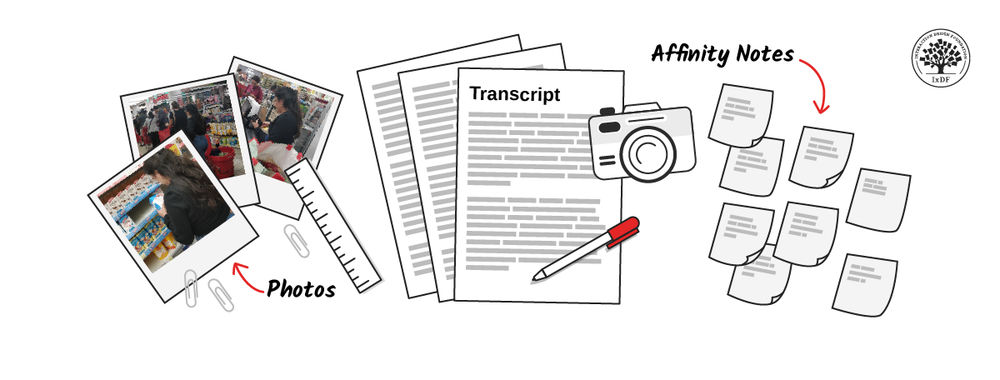
We believe in Open Access and the democratization of knowledge. Unfortunately, world-class educational materials such as this page are normally hidden behind paywalls or in expensive textbooks.
If you want this to change, , link to us, or join us to help us democratize design knowledge!
